The Wooden Collection
Antique Seal Stamps Crafted from Precious Woods, including Ebony, Walnut, and Rosewood
The style of the engraving on this stamp suggest an origin within the French or Belgian heraldic tradition, particularly due to the ornate floral ornamentation and the detailed rendering of the helm and mantling. Six-pointed stars are a common feature in German, Swiss, and French heraldry. While the specific combination of a chevron, stars, and a flower is relatively uncommon, it was used in various forms by several noble and bourgeois families in France and Wallonia between the 17th and 19th centuries.



Precious Woods in the Art of Wax Seal Handles.
Wooden-handled wax seal stamps were among the most widespread types from the 17th through the 19th centuries, ranging from modest utilitarian forms to exquisite objects of personal refinement. For high-end stamps, craftsmen favored precious and exotic woods such as ebony, rosewood, kingwood, amboyna burl, and cocobolo. All were admired for their dense grain, rich coloring, and natural polish. These woods were often imported through colonial trade networks, sourced from South America, Africa, India, or the East Indies, and were selected for both durability and beauty. Their rarity and the difficulty of working them elevated such stamps far above the commonplace, making them coveted accessories for aristocrats, diplomats, and collectors. To highlight the luxury of these woods, skilled turners would shape the handles on lathes into elegantly balanced profiles, often in baluster or domed forms, which allowed the grain to catch the light from multiple angles. The wood was then polished to a lustrous sheen using oils, waxes, and fine abrasives, enhancing its depth and texture without needing additional ornamentation. In some cases, small details were carved into the surface to emphasize the craftsmanship. The result was a handle that was not only functional, but also tactile, sensual, and expressive of the owner's personal taste and refinement.

This stamp belonged to Marie-Louise-Laurence du Rocher du Quengo (1767–1844), Countess of Quengo. She was the daughter of Louis-Jean Ménard and Jeanne-Charles de Portelance. In 1792, she married Gabriel-Pierre-Louis du Rocher du Quengo, a marine officer from an old noble family in Brittany, who was killed four years later. She was also the niece of Count Jean-François de La Marche, Bishop of Saint-Pol-de-Léon, who died in exile in England. Jean-François de La Marche was the last bishop-count of the Diocese of Léon (Finistère), which he led from 1772 until the seat was abolished in 1801 by Pope Pius VII. In March 1816, King Louis XVIII appointed Marie-Louise as superintendent of the Royal House of the Daughters of the Legion of Honor in Saint-Denis. This noble and devout lady endeavored to instill a spirit of faith and religious practice within the institution.

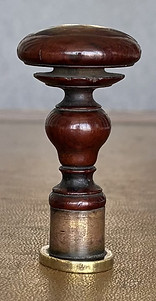

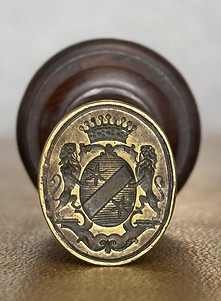

Marie-Louise du Rocher du Quengo

The stamp of Countess Marie-Louise du Rocher du Quengo

Jean-Francois de La Marche
This coat of arms is a good example of the "chapé-ployé" partition. In heraldry, chapé-ployé refers to a two-colored field, divided by an inverted v with curved lines which extends to the top of the field. The coat of arms could be described as: Tierced in chape-ployé: dexter Gules, a lion rampant contourné; sinister Or, an eagle displayed Sable; in base Sable, a plant issuant. The single-headed eagle is often tied to the Holy Roman Empire, Prussian, or northern Italian noble lineages.
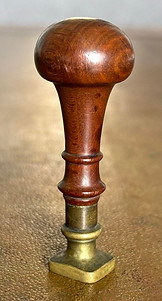
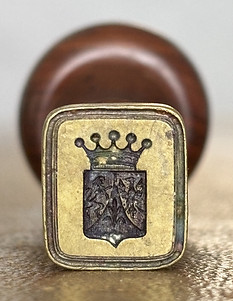

This stamp may have belonged to a descendant of the du Rufflay family. The history of the family is little known, and few records remain, as most public documents were destroyed. This family is said to have been originally known as Gascoing. The coat of arms is: Argent, a chevron Gules, accompanied by three cinquefoils.



This is a finely crafted wax seal, most likely belonging to a nobleman or a high-ranking civil official - perhaps a judge, senator, or mayor - active within the legal-administrative framework of the Austro-Hungarian or German states during the 18th or 19th century. The Latin motto, “Amor Patriae Emulatur Juris Mei” (“Love of the fatherland emulates my rights”), expresses a sense of duty in which patriotism is held in equal or even greater regard than personal legal privilege.
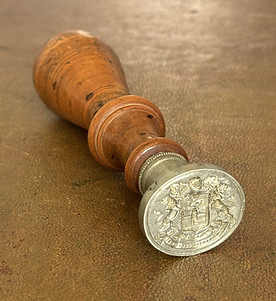


Some stamps in the collection are certainly not masterpieces. This one, for instance, features a fairly average design and engraving. However, every stamp has the potential to offer new knowledge. In Spain, the arms of the Counts of Ezpeleta were "Argent, a lion rampant Gules", not too far from what we see in this example. The title "Count of Ezpeleta de Beire" was established in 1797 by King Charles IV of Spain for José Manuel de Ezpeleta y Galdeano. He was a distinguished Spanish military officer and politician, serving as the governor of Cuba from 1785 to 1789 and as the viceroy of New Granada from 1789 to 1797. He also held the position of viceroy of Navarre from 1814 to 1820. The family held the titles for several generations, from José Manuel's son, José María de Ezpeleta y Enrile (1787–1847), who became the second Count, followed by other family members, including Joaquín de Villar-Villamil y Ezpeleta (1899–1984). Son of the fifth countess, he succeeded to the title but had no descendants.

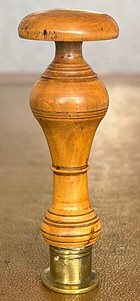
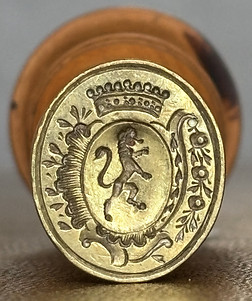

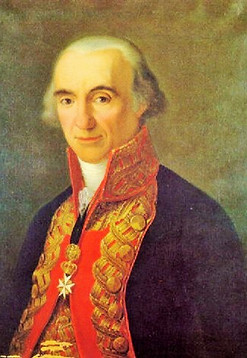

.jpg)
José de Ezpeleta y Galdeano
Coat of arms at the Ezpeleta Palace
Joaquín Ezpeleta Enrile
While the engraving of this stamp is not of the highest finesse, it remains an appealing object... thanks to its handle. The engraved coat of arms presents similarities with the arms of the Millon de Montherlant family: On a green field, a silver tower enflamed in red, surmounted by two silver swords, crossed in saltire. However, the shield of the stamp is Or (gold), so we can assume that it belonged to another family. Nevertheless, research led me to know more about the Millon de Montherlant, a distinguished bourgeoise family from Picardy. They owned the Château de Montherlant, a property acquired in 1755. The Montherlant branch of the family was non-noble, but there are accounts indicating that the use of titles such as "comte" (count) by family members like Joseph Millon de Montherlant in the early 20th century was likely self-assumed.







This is a beautiful and well-preserved German antique wax seal stamp, likely from the 18th or early 19th century. Based on the engraving style, and symbols, it could originate from Bavaria, Franconia, or Swabia. But it could also be Austrian if from a border region. What I find interesting in the coat of arms is that the two wings above the helm are each charged with a small version of the shield’s principal figure. We can indeed see small repeats of the Dreiberg (mount of three tops) and the stars shown on the Azure shield.



This is the stamp of the French le Roy family (Normandy), whose members were Marquis of Valanglart, Counts of Quesnoy and Barde, and Lords of Bezancourt. It is a noble French family with origins traceable to the Ancien Régime. While not among the most prominent noble houses in French history, they held recognized noble status.



A stamp of the French family Le Vaillant du Châtelet et de Jollain en Ponthieu. The coat of arms of this particular stamp could have belonged to the wife of Alexandre Le Vaillant de Jollain, who was Lieutenant of the Marshals of France in the northern city of Aras. We can see a crown of Count in the engraving, but he was not a Count, he was only Ecuyer. On the other hand, his wife, Marie Catherine de Brandt, was the daughter of Count Alexandre de Brandt (1758-1776), Count of Marconne, who was also Lieutenant of the Marshals of France. This could explain the presence of the crown. Alexandre de Brandt held the noble title of Comte de Brandt (Count of Brandt) and Marconne. He was married to Louise Marie Anne Barbin de Broyes, Countess d'Autry.


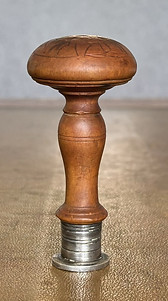



The seal is engraved with a coat of arms similar to the Péteri Takáts family (Takáts de Péteri, Pétery Takáts, or Takács de Péteri), which is an old Hungarian noble lineage, traditionally associated with the settlement of Péteri, today near Monor in Pest County. Families bearing the name Takáts (or Takács) are numerous in Hungary, but the branch “de Péteri” is among the legally recognized nemes (noble) families documented from the 17th century onward. The round shape of the shield tells us that it would have belonged to a lady.



This may be a rather old-looking stamp, but I like it. It seems to have been used quite a lot. Apart from the lion (Dexter supporter) and the eagle (Sinister supporter), the figure of the crest is interesting: A knight holding a Christian cross and a sword. I don't know to which family the stamp belonged, but an Azure shield with three chess rocs is similar to the arms of the de Roquelaure family, who were dukes of Roquelaure and marquis of Biran, among other titles. Antoine de Roquelaure was the third son of Géraud, lord of Roquelaure, (died 1557), and Catherine de Bezolles. As such he was originally destined by his father for an ecclesiastical career, but at his father's death, he inherited the seigneurie of Le Longard and placed himself in the service of Antoine of Navarre. This could link to the knight holding a cross in the crest. Wild speculation on my part, of course...



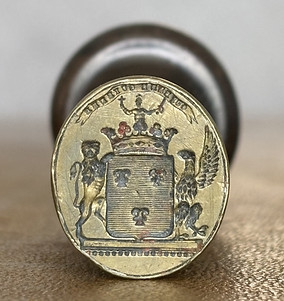

Although the round shape of the shield on this seal would indicate that it belonged to a noble woman of the de Prie family, the decorations engraved all around it point to Louis de Prie, Marquis de Plasnes. He belonged to the later branch of the distinguished Norman and Bourbonnais family de Prie. Born into a lineage long connected with royal service, he became best known through his marriage to Jeanne-Agnès Berthelot de Pléneuf, the influential Marquise de Prie, a prominent figure at the court of Louis XV. As marquis, Louis de Prie held estates at Plasnes in Normandy and maintained the traditional responsibilities of a provincial nobleman, divided between estate management and court presence. Though overshadowed by his wife’s political role, he remained a steady representative of his family’s status within the French noblesse.



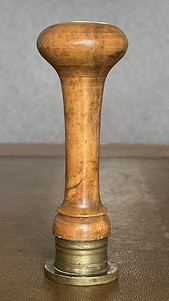

Marquis Louis de Prie

Jeanne Agnès Berthelot, Marquise de Prie

Louise de Prie de La Mothe-Houdancourt
The coat of arms of this stamp is rather interesting and beautifully carved, with symbols that are rather uncommon, such as the eye in the dexter shield and the bretessed bend in the sinister shield. The eye could symbolize vigilance or enlightenment symbolism. The bretessed bend is a heraldic term used to describe a bend (a diagonal band) that has embattled (castle-like) indentations along both its upper and lower edges, but in a mirrored or alternating pattern.
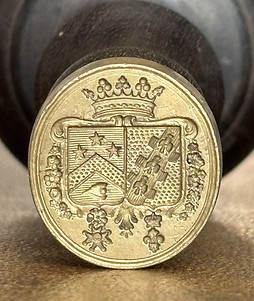


A seal stamp acquired from Holland. I have yet to find the original Dutch owner of the coat of arms, if the stamp indeed originates from the Netherlands. In France, some families bore similar arms, though none appear to have been counts, as the crown on this particular engraving suggests.

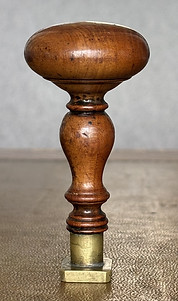
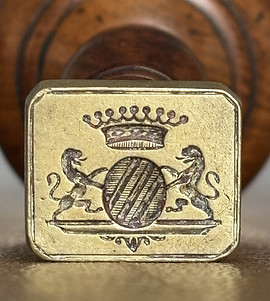

This is a finely engraved heraldic seal, rich in stylistic details. It features a pair of buffalo horns issuing from a tournament-style helmet, with flowing and stylized mantling, elements characteristic of Germanic or Swiss heraldry, particularly in southern Germany, Austria, and Switzerland. The front-facing helmet with horns, combined with the absence of a coronet, suggests that these are burgher arms (belonging to the urban patriciate or non-noble class), or possibly those of the lesser nobility within the heraldic traditions of the Holy Roman Empire. The buffalo horns are a common crest motif in German and Swiss heraldry, often bearing personal or regional symbolism. The combination of the rose and the fleur-de-lis is also significant: the rose can represent hope or secrecy (sub rosa), while the fleur-de-lis may symbolize purity, Marian devotion, or ties to France. Taken together, these elements suggest that the seal likely belonged to a German or Swiss family of burgher or minor noble status, active between the 17th and 19th centuries.


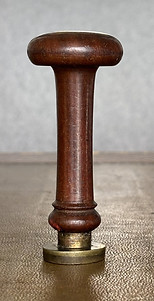



Massive engraving with two coats of arms, symbolizing the alliance of two families through marriage. The left shield is the one of a member of the French family de Salmon, lords of the Chastelier. We can read the motto of the family at the top: "Moi franc (et) sans dol", which translates to "I am frank and without deceit" in English.


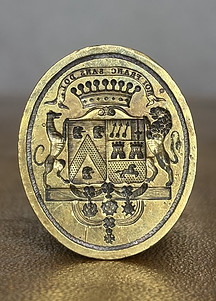

This wax seal stamp is said to have belonged to Nicolas Deslandes, a prominent shipbuilder of the Grandville Harbour in Normandy, France. Grandville sits on the coast of the English Channel. The interesting part in the coat of arms is certainly the canon. Nicolas Deslandes made his fortune by founding a shipbuilding company in 1768, which played a significant role during the American War of Independence. His services earned him nobility in 1783, when he received the title of Ecuyer, Squire in English, a title below Knight.



This family coat of arms can be described as: Azure, a fess Or, charged with 3 shells. The origin of this stamp is unknown, but a family that had a similar crest was the Juchault family, originating from Brittany. The family formed several branches, of which only the des Jamonières branch remains. The others are the de Lamoricière branch, and the de Blottereau branch. Among the personalities of the family were Louis-Marie Juchault, Lord of Jamonières, (1769-1842) and Baron of the Empire, and Christophe Louis Léon Juchault de Lamoricière (1806-1865), who was general, diplomat, and politician, governor-general of Algeria, Minister of War, and ambassador of France to Russia. These faraway posts may explain the presence of scallop shells, which in heraldry, often symbolize pilgrimage and travel. They can also represent protection, divine grace, and faithful service.




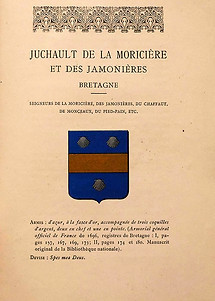
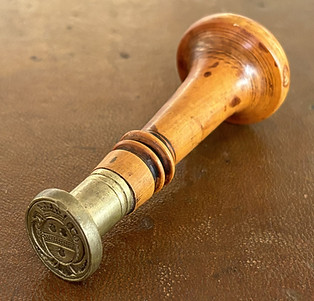
The shield on this stamp is party per pale, featuring two distinct halves. The lower part of the dexter side shows a pattern consistent with vair, a heraldic fur depicted as alternating bell-like shapes. This was a symbol of nobility and high status. The upper part shows a plant issuing from the ground. The sinister side shows three birds on corn stalks. This association could reflect a marriage between an old noble house (vair side) and a landed or agrarian family, potentially from France, northern Italy, or Belgium.



This antique stamp belonged to a family member of Jean Philibert de Constantin, who held the noble title of Marquis de Chanay. He was a member of the Constantin family, a noble lineage associated with the region of Chanay in the Ain department of France. The family owned the castle of Dorches (Château de Dorches), a medieval fortress located in Chanay, which they acquired around 1740. The château's origins date back to the early 12th century, and it has been recognized as a historical monument. Only ruins of the castle remain nowadays. The family belongs to the nobility of Bugey. It was honorably known in this region as early as the 17th century. After the Revolution, the Constantin de Chanay family settled in Dauphiné following the marriage of its head with Marie de Meffray.





The engraving on this seal is particularly elegant. The shield appears to be charged with nine crosses pattée (Croix pattée), arranged 4-3-2 from top to bottom. The cross pattée is traditionally associated with military valor, Christian faith, or connections to crusading orders such as the Teutonic Knights or the Knights Hospitaller, depending on the historical and familial context. So far, I have not been able to identify a French noble family bearing a coat of arms with this specific design, and further research is still needed.



This is a stamp bought from Austria. The coat of arms shows a double-headed eagle which can symbolize the Austro-Hungarian Empire. Nowadays, the double-headed eagle is not used anymore in modern Austria. Indeed, the country's coat of arms now features a single-headed eagle. The double-headed eagle was a prominent symbol of the Austro-Hungarian Empire and, before that, the Holy Roman Empire, of which Austria was a central part. The Austro-Hungarian Empire was a multinational empire in Central and Eastern Europe that existed from 1867 to 1918, and was one of the major powers of Europe, spanning much of modern-day Austria, Hungary, the Czech Republic, Slovakia, parts of Poland, Ukraine, Romania, Italy, and the Balkans. After the fall of the Austro-Hungarian Empire in 1918, Austria adopted the single-headed eagle. In today's heraldry, the double-headed eagle is still used in a few countries, particularly those with historical ties to the Byzantine or the Holy Roman Empire, such as Russia, Serbia, Albania, or Montenegro.
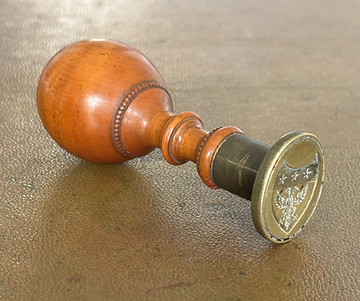




It is not possible to identify the owners of this stamp, since several families of Europe have a coat of arms "Or, a cross Azure", such as the French de Breteuil family, the Bohun of Midhurst family, a cadet branch of the House of Bohun, in England, or the Telio family in Italy. Even the municipality of Novigrad in Croatia has such arms.

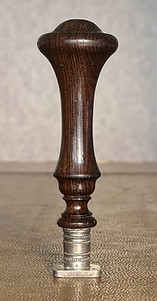
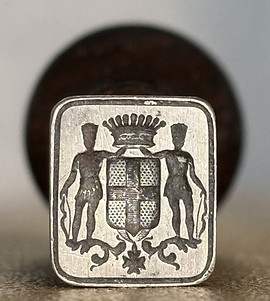

Antique French Wax Seal Stamp from Célestin Nanteuil Gravure, Grenoble (1813-1873). While the engraving is rather simple, I find it interesting to look at the marks on the handle. Célestin Nanteuil was a notable French engraver, known for his exquisite work in the field of engraving and printmaking. He is known to have engraved coats of arms among his various works. His skills in engraving were applied to a range of subjects, including heraldic designs.



This is a seal stamp of the French family Camusat de Riancey. The Camusat family originates from the Champagne region and was ennobled in 1709. It descends from long-established residents of Troyes and remained deeply loyal to the French monarchy, particularly the Bourbon dynasty. The branch known as the Counts and Viscounts of Riancey is now extinct. Three main lines can be identified: the Camusat de Riancey et de Rilly line, the Camusat de Villiers, de Bellombre et de Vaugourdon line, and the Camusat des Carrets et de Busserolles line. Their coats of arms—Azure, a chevron Or between three ram's heads Argent—appear to be similar across the branches, though there may have been slight variations. On this particular seal stamp, for example, the chevron appears to be Argent rather than Or. Renowned French writer Henry de Montherlant was the son of Joseph-Marie Millon de Montherlant and Marguerite Camusat de Riancey.




.jpg)
Henri-Léon Camusat de Riancey
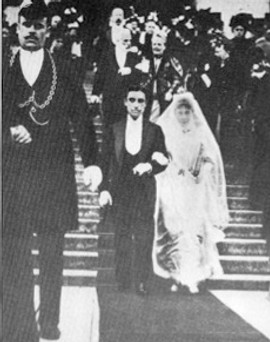
Joseph de Montherlant and Marguerite de Riancey
.jpg)
Marguerite Camusat de Riancey
Another stamps that produced a nice surprise. When it arrived from Italy, the coat of arms was not easy to analyze. But after some cleaning using an ultrasound machine, it revealed a nice engraving. This seal likely belonged to a bourgeois or newly ennobled family, active during the late 18th or early 19th century. The coat of arms can be interpreted as: In chief, a beehive between two lions holding tools; in base, a fess above three stars and a flower.
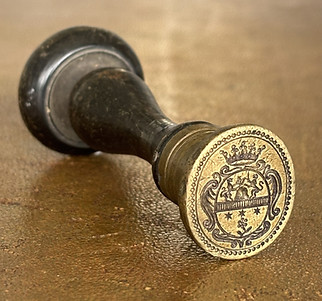

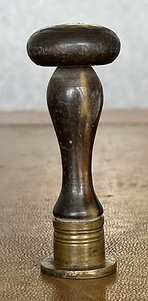
This is a Roman Catholic ecclesiastic seal, which belonged to Gervais-Joseph Ortric, Bishop of Pamier, in Ariège, France, from 1835 until his death in 1845. On the shield, we can see a lamb passant, bearing a Christian banner. This is the Agnus Dei, or "Lamb of God", a central Christian symbol representing Christ as the sacrificial lamb. Above the lamb is a radiant star or sunburst, symbolizing divine light, often interpreted as the presence of God or the Holy Spirit. At the top is a galero, the traditional ecclesiastical hat used in heraldry to indicate clerical rank, a bishop, in this case. Gervais-Joseph Ortric (1788–1845), born in Montpellier, was ordained a priest in 1813 and became vicar general before his episcopal appointment under King Louis-Philippe. As bishop, he devoted himself to reorganizing diocesan institutions and promoting religious education in the Ariège region.





Coat of arms of Gervais-Joseph Ortric, Bishop of Pamiers

Monseigneur Gervais-Joseph Ortric

Catechism of the diocese of Pamiers
This is likely the only seal stamp in the collection with an octagonal base. It may seem like a small detail, but it adds a touch of uniqueness. The provenance of the stamp remains uncertain, and I have not yet identified the family to which this coat of arms belongs. It may be blazoned as: Azure, a stag passant, in chief three mullets of five points; the shield ensigned with a count's coronet and supported by two griffins rampant. The overall style is consistent with heraldic traditions from French, Belgian, or southern German regions.



This stamp belonged to a member of the de Chaponay family, an extinct family of the French nobility. The lineage ended in 1956 when Antoine de Chaponay died without leaving a male heir, and, for the female line, in 2019 when his daughter Henryane passed away. The Chaponay family has a complex genealogy. The Lords of Chaponay were titled Marquis de Chaponay-Morancé. Under the engraved shield of the family, we can see the medal of the Order of St Lazarus. The Order of Saint Lazarus is one of the most ancient of the European orders of chivalry, dating back to the time of the Crusader knights. From its foundation in the 12th century, the members of the Order have been dedicated to two ideals: aid to those suffering from the disease of leprosy and the defense of the Christian faith.





Following some research in the Armorial General of France, we learn that the arms engraved on this seal stamp were registered by Agnès Pocquelin, who married Pierre de Loynes, lord of Parassy. Her arms are different than the arms of the Pocquelin family. This suggests that the registration under her maiden name, Poquelin, aligns with the practices of the time, where women's arms were recorded under their own family names. The entry in question likely pertains to a Madame Poquelin, wife of Pierre de Loyne, who registered her arms as “Sable, a fess Or”. The Armorial Général de France, initiated by Louis XIV and overseen by Charles-René d’Hozier, was not merely a heraldic registry but also a fiscal measure. Individuals and entities were required to register their coats of arms and pay a fee, effectively making it a tax scheme. It is not uncommon to find multiple coats of arms associated with the same surname.





This stamp was sold to me from the Netherlands as belonging to the French family de Charpentier, Lords of Chavagnac. The coat of arms is "Azure, a chevron Or between two crescents in chief and a rose in base". The de Charpentier family is known since 1315. The lords of Chavagnac are the descendants of Rigaud de Charpentier.



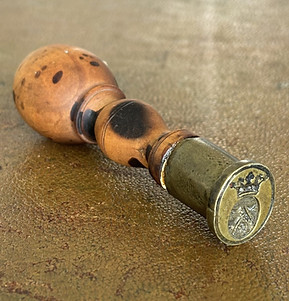
Gerry's Collection of Antique Seal Stamps.









